The Snapdragon 855 Performance Preview: Setting the Stage for Flagship Android 2019
by Andrei Frumusanu on January 15, 2019 8:00 AM EST- Posted in
- Mobile
- Qualcomm
- Smartphones
- SoCs
- 7nm
- Snapdragon 855
Inference Performance: Good, But Missing Tensor APIs
Beyond CPU and GPU, the one aspect of the Snapdragon 855 that Qualcomm made a lot of noise about is the new Hexagon 690 accelerator block.
The new unit doubles its vector pipelines, essentially doubling performance for traditional image processing tasks as well as machine inferencing workloads. Most importantly, Qualcomm now includes a dedicated “Tensor Accelerator” block which promises to even better offload inferencing tasks.
I’ve queried Qualcomm about the new Tensor Accelerator, and got some interesting answers. First of all- Qualcomm isn’t willing to disclose more about the performance of this IP block; the company had advertised a total of “7 TOPS” computing power on the part of the platform, but they would not dissect this figure and attribute it individually to each IP block.
What was actually most surprising however was the API situation for the new Tensor accelerator. Unfortunately, the block will not be exposed to the NNAPI until sometime later in the year for Android Q, and for the time being the accelerator is only exposed via in-house frameworks. What this means is that none of our very limited set of “AI” benchmarks is able to actually test the Tensor block, and most of what we’re going to see in terms of results are merely improvements on the side of the Hexagon’s vector cores.
Inference Performance
First off, we start off with “AiBenchmark” – we first starred the new workload in our Mate 20 review, to quote myself:
“AI-Benchmark” is a new tool developed by Andrey Ignatov from the Computer Vision Lab at ETH Zürich in Switzerland. The new benchmark application, is as far as I’m aware, one of the first to make extensive use of Android’s new NNAPI, rather than relying on each SoC vendor’s own SDK tools and APIs. This is an important distinction to AIMark, as AI-Benchmark should be better able to accurately represent the resulting NN performance as expected from an application which uses the NNAPI.
Andrey extensive documents the workloads such as the NN models used as well as what their function is, and has also published a paper on his methods and findings.
One thing to keep in mind, is that the NNAPI isn’t just some universal translation layer that is able to magically run a neural network model on an NPU, but the API as well as the SoC vendor’s underlying driver must be able to support the exposed functions and be able to run this on the IP block. The distinction here lies between models which use features that are to date not yet supported by the NNAPI, and thus have to fall back to a CPU implementation, and models which can be hardware accelerated and operate on quantized INT8 or FP16 data. There’s also models relying on FP32 data, and here again depending on the underlying driver this can be either run on the CPU or for example on the GPU.

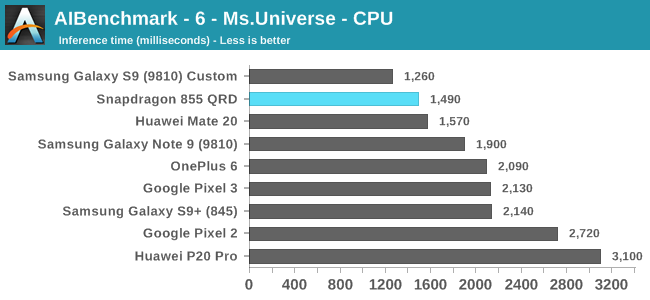
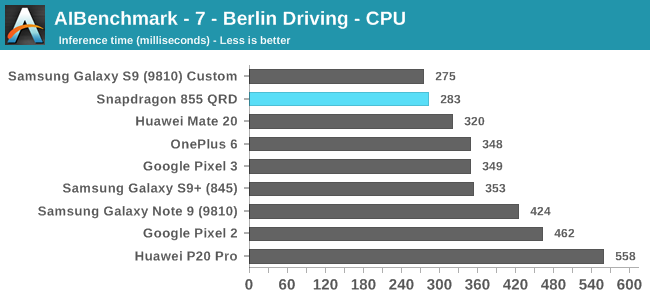
In the first set of workloads which I’ve categorised by being run on the CPU, we see the Snapdragon 855 perform well, although it’s not exactly extraordinary. Performance here is much more impacted by the scheduler of the system and exactly how fast the CPU is allowed to get to its maximum operating performance point, as the workload is of a short burst nature.
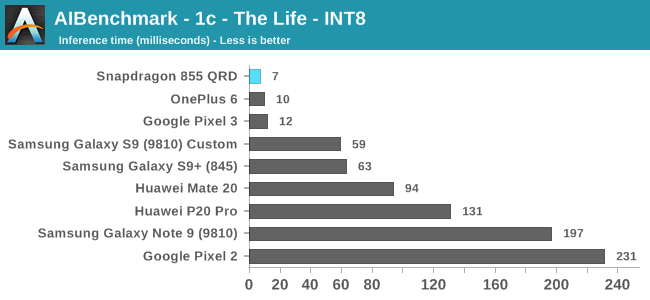
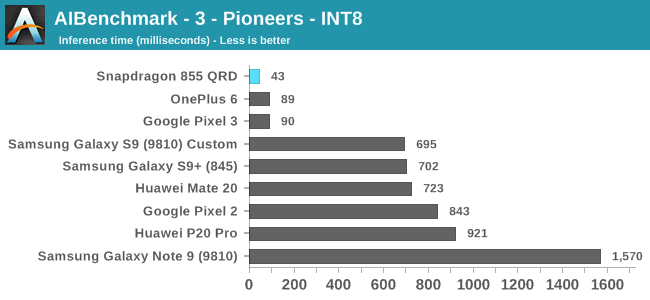
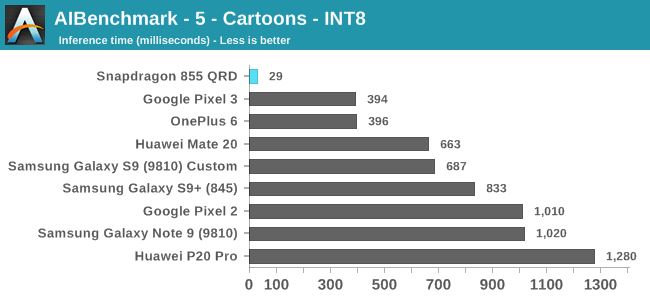
Moving onto the 8-bit integer quantised models, these are for most devices hardware accelerated. The Snapdragon 855’s performance here is leading in all benchmarks. In the Pioneers benchmark we more clearly see the doubling of the performance of the HVX units as the new hardware posts inference times little under half the time of the Snapdragon 845.
The Cartoons benchmark here is interesting as it showcases the API and driver aspect of NNAPI benchmarks: The Snapdragon 855 here seems to have massively better acceleration compared to its predecessors and competing devices. It might be that Qualcomm has notably improved its drivers here and is much better able to take advantage of the hardware, compared to the past chipset.
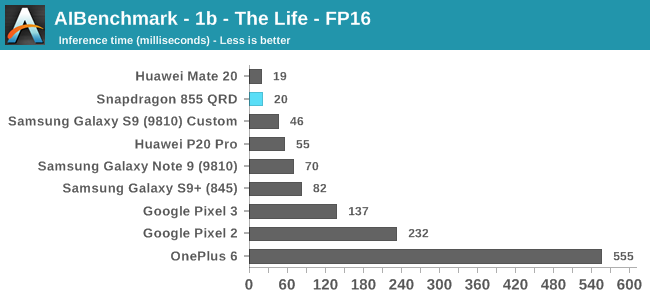
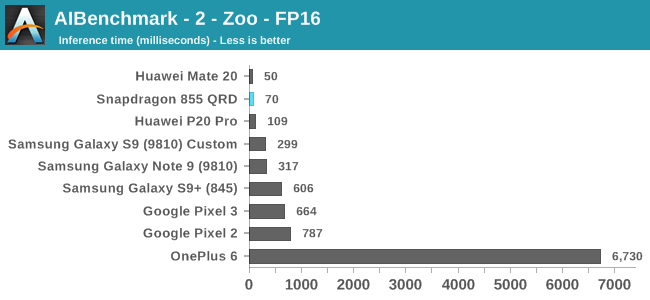
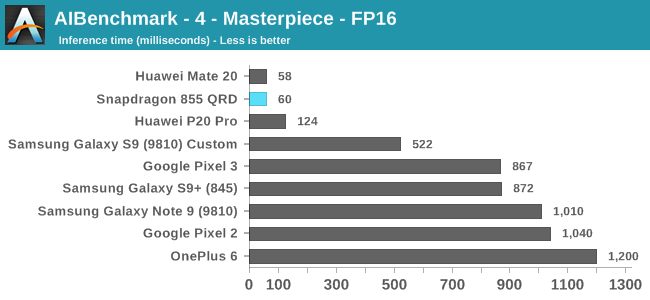
The FP16 workloads finally see some competition for Qualcomm as the Kirin’s NPU exposes support for its hardware here. Qualcomm should be running these workloads on the GPU, and here we see massive gains as the new platform’s NNAPI capability is much more mature.
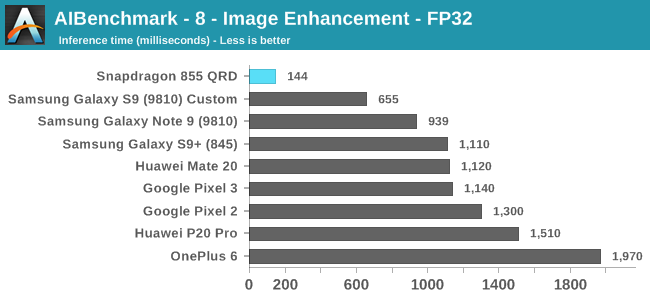
The FP32 workload sees a similar improvement for the Snapdragon 855; here Qualcomm finally is able to take full advantage of GPU acceleration which gives the new chipset a considerable lead.
AIMark
Alongside AIBenchmark, it still might be useful to have comparisons with AIMark. This benchmark rather than using NNAPI, uses Qualcomm’s SNPE framework for acceleration. Also this gives us a rare comparison against Apple’s iPhones where the benchmark makes use of CoreML for acceleration.
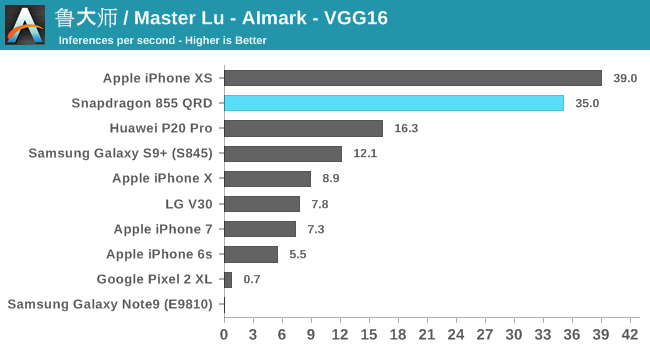
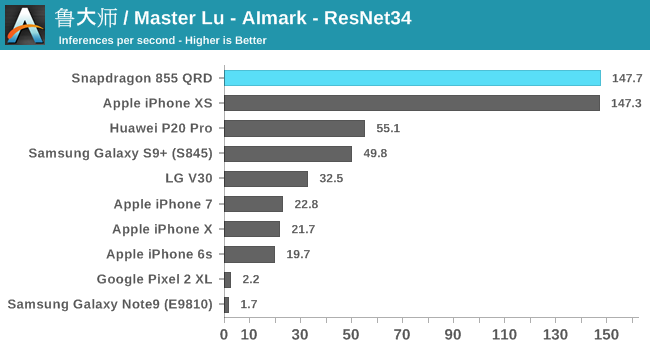
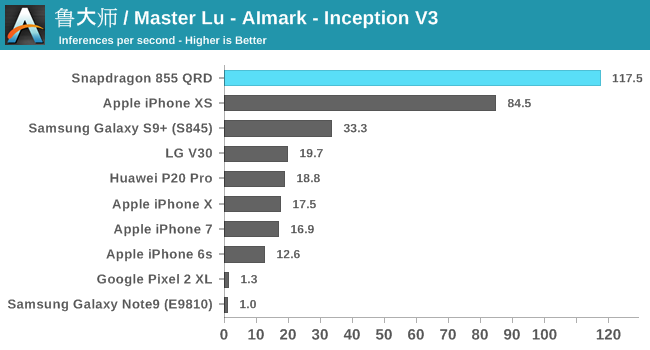
Overall, the Snapdragon 855 is able to post 2.5-3x performance boosts over the Snapdragon 845.
At the event, Qualcomm also showcased an in-house benchmark running InceptionV3 which was accelerated by both the HVX units as well as the new Tensor block. Here the phone was able to achieve 148 inferences/s – which although maybe apples to oranges, represents a 26% boost compared to the same model run in AIMark.
Overall, even though the Tensor accelerator wasn’t directly tested in today’s benchmark results, the Snapdragon 855’s inference performance is outstanding due to the overall much improved driver stack as well as the doubling of the Hexagon’s vector execution units. It will be interesting to see what vendors do with this performance and we should definitely see some exciting camera applications in the future.


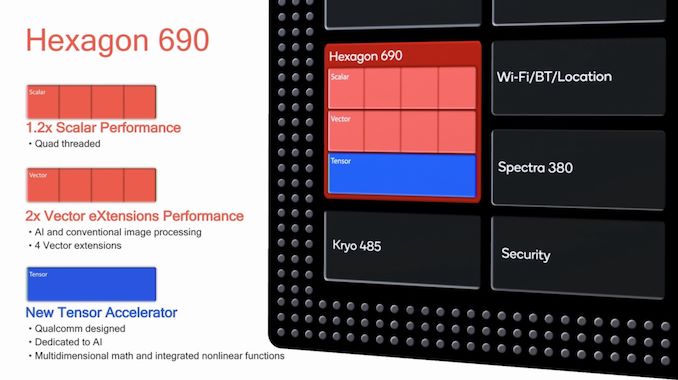








132 Comments
View All Comments
Midwayman - Wednesday, January 16, 2019 - link
People would have said that about AMD not long ago.... Just saying.29a - Wednesday, January 16, 2019 - link
They used the same engineer, Jim Keller. He works for Intel now.Midwayman - Wednesday, January 16, 2019 - link
Eventually, sure. Apple will stall out on process related stuff eventually and they'll have a chance to catch up. Unlikely until then as they're still making big gains too and have a 2-3 year lead.jjj - Tuesday, January 15, 2019 - link
We need a bit more on the GPU side in the next years for foldable. Pixel count will increase, SoC power needs to decrease (more power and mechanical volume goes towards the display) and mobile gaming should gain in popularity with x2+ larger displays.levizx - Tuesday, January 15, 2019 - link
We can establish that single core performance/power is good, but what about multi-core? Wouldn't the other 3 big core be running at the highest voltage while potentially running at ~2GHz in real world workload?Andrei Frumusanu - Tuesday, January 15, 2019 - link
Correct. We'll have to see how efficiency performs once we get commercial devices.Chaser - Tuesday, January 15, 2019 - link
We read about all this when the 845 was about to launch a year ago. I didn't see some monumental improvement in responsiveness or efficiency despite all these whitepapers stating so. Unless you are so kind of smartphone gaming fanatic, real-world use differences between each year look great mostly on paper.SquarePeg - Tuesday, January 15, 2019 - link
Performance has been good enough since 2013 with the release of the SD 800. Every year we get a performance bump that just gets offset by feature bloat that doesn't really improve performance outside of benchmarks. I can pull out my old LG G2 running an Android 4.4.2 custom ROM/kernel and that thing just flies compared to any phone from the past year.A5 - Tuesday, January 15, 2019 - link
I promise you it won’t. SD 800 will feel terribleyeeeeman - Wednesday, January 16, 2019 - link
I have a Z3 compact, which is a SD801. Bought recently a Galaxy S7 second hand to replace the Z3. I can safely say that the Exynos 8890 is noticeably faster in opening apps, playing intensive games and generally in multitasking. Z3 usually lags when phone is started for first time and many apps sync. Galaxy S7 is buttery smooth. So yeah, I think we can feel the progress in performance of these chips, but maybe at a later point when apps get to their limit of computing power. Then you actually see that a newer chipset is noticeably faster.But nevertheless, the Z3 compact with SD801 is still a great fast phone. It runs a bit slower than the Exynos as I said but in general it is not slow at all on Android 6.0. So yeah, a chipset like it could be easily used in today's times if you don't a bit of slow down here and there.